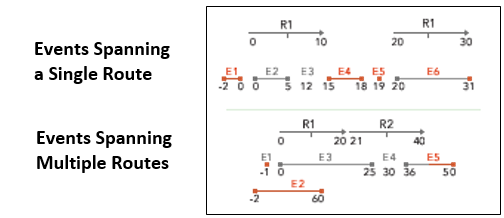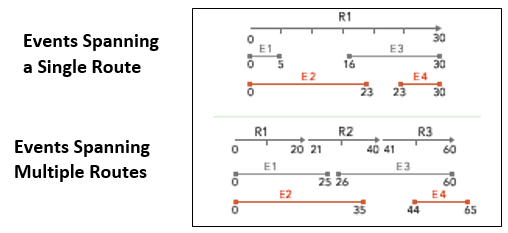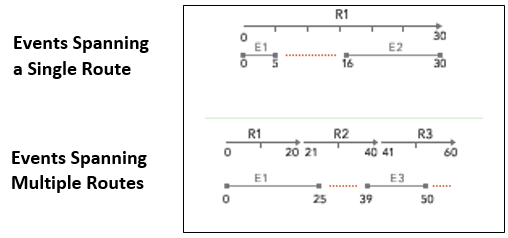Available with Data Reviewer license.
Summary
The Invalid Events check finds linear referenced events that do not have an associated route (orphaned events) or contain invalid measure values. The check also identifies gaps or overlaps between events within the same route or across multiple routes.
Overview
The purpose of the Invalid Events check is to identify linear referenced events that have errors that may impact analysis and asset management workflows. Error conditions that can be detected with this check include the following:
- Orphaned events—Events that do not have associated route features.
- Events with invalid measures—Events that contain measure values outside the range of those in related route features. This includes event measures that are greater than, less than, or within a gap in a related route's measure values.
- Overlapping events—Linear event features that overlap event features of the same category within the same route or across multiple routes.
- Events with gaps—Linear event features that represent gaps between other event features within the same route or across multiple routes.
Industry scenarios
- In roadway management, a speed limit event representing 55 mph needs to have the same measure value as the related route feature.
- In roadway management, event features that contain invalid measure values adversely affect length calculations (for example, United States Department of Transportation mileage reports).
- In pipeline management, recording of the protective coating applied to underground assets ensures accurate reporting on features that cannot be directly observed during inspections.
- To avoid pipeline corrosion, recording the measure of protective coating applied to underground assets ensures accuracy of reporting and safety of underground features.
Examples
Invalid Events—The image below illustrates point and linear events (in red) that contain invalid measure values.
Overlaps—The image below illustrates linear events (in red) that overlap other events within the same route or across multiple routes.
Gaps—The image below illustrates missing linear events (in red) that represent gaps between other events within the same route or across multiple routes.
Supported workflows
ArcGIS Data Reviewer checks support multiple methods for implementing automated review of your data. The following table identifies the supported implementation methods for this check:
| Validation | Constraint | ||
|---|---|---|---|
Reviewer batch job | Reviewer map rule | Attribute (validation) rule | No |
Yes | Yes | No | |
Syntax
| Parameter | Required | Explanation | Workflows |
|---|---|---|---|
Input Event Layers | Yes |
The input feature layers evaluated by the rule. Valid inputs for this rule type are point and
polyline feature layers. Click the Forward button | Validation |
Input Route Layer | Yes | The feature layer to which events are referenced. Valid inputs for this rule type are m-enabled
polyline feature layers. Click the Forward button | Validation |
Event Route Identifier | Yes | The name of the field that contains values used to associate events to routes. The field must be a numeric data type. | Validation |
Event From Measure | Yes | The name of the field that contains the starting measure value for a point or linear event feature. The field must be a numeric data type. | Validation |
Event To Measure | Yes | The name of the field that contains the ending measure value for a linear event feature. The field must be a numeric data type. | Validation |
Route Identifier | Yes | The name of the field that contains values used to associate routes to events. The field must be a numeric data type. | Validation |
Search Goal | Yes | Error conditions evaluated by the rule.
| Validation |
Measure Tolerance | No | Optional value used when finding events that have invalid measures or represent a gap or overlap on other events. | Validation |
Title | No | A unique title or name for the rule. This information is used to support data quality requirement traceability, automated reporting, and corrective workflows. | Validation |
Notes | No | Descriptive text of the error condition when noncompliant features are found. This information is used to provide guidance to facilitate corrective workflows. | Validation |
Severity | No | Severity of the error created when noncompliant features are found. This value indicates the importance of the error relative to other errors. Values range from 1 to 5, with 1 being the highest priority and 5 being the lowest. | Validation |
Tags | No | Tag property of the rule. This information is used in rule authoring and management workflows to support traceability and reporting of data quality requirements. | Validation |
Notes
- The Invalid Events check supports validation of events stored in the following:
- Line feature classes
- Point feature classes
- A Route ID field (numeric data type) is required for all events.
- The event's related Route Source feature layer must be M-enabled.
- Optionally, you can define a Tolerance value that will be used when finding events that have invalid measures or represent a gap or overlap on other events. This value cannot be less than the M-tolerance value of the Input Route Layer. For more information, see The properties of a spatial reference.
- Events associated with nonmonotonic route features are not evaluated by this check. Nonmonotonic routes are those that contain measure values that are either continuous or not strictly increasing or decreasing in value.
The Monotonicity check is used to find nonmonotonic routes that require correction.
- Events that do not have an associated route (orphaned events) are not evaluated by either the Find overlaps or Find gaps search criteria. Orphan events are those features that do not have a corresponding route feature (as identified by the event’s RouteID attribute value).
- Events that contain invalid measure values are not evaluated by either the Find overlaps or Find gaps search criteria. Invalid event values are those measure values that are greater than, less than, or within a gap in a related linear feature’s measure values.
The Find invalid measures option finds events with invalid measure values and is automatically enabled with either the Find overlaps or Find gaps search criteria.
- The following scenarios are not currently supported when using the Find overlaps or Find gaps search criteria:
- Events associated with multipart route features that contain gaps in measure values between parts
- Events associated with multiple route features during the same time period
- When using the Find Gaps search goal, the map should be zoomed to the full extent of the route layer before features are validated using the Run Reviewer Rules command. Doing so will ensure that all gap error scenarios are detected.
- When this check is authored as a map-based rule, care should be taken when configuring filter parameters using database-specific SQL functions that differ from those supported in your production environment.
 to apply filtering to specific features in the feature layer.
to apply filtering to specific features in the feature layer.